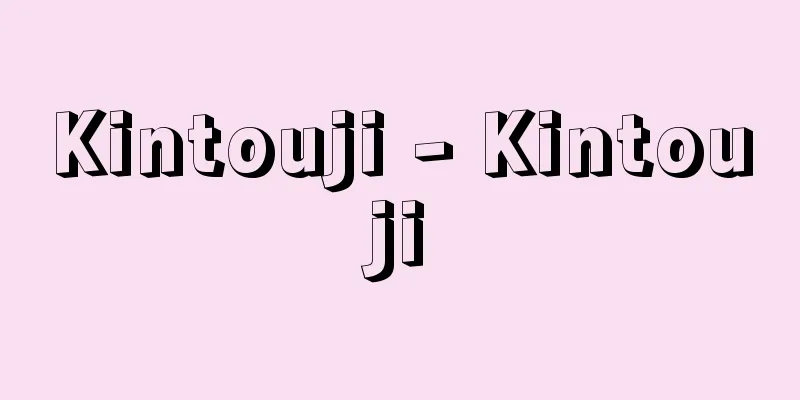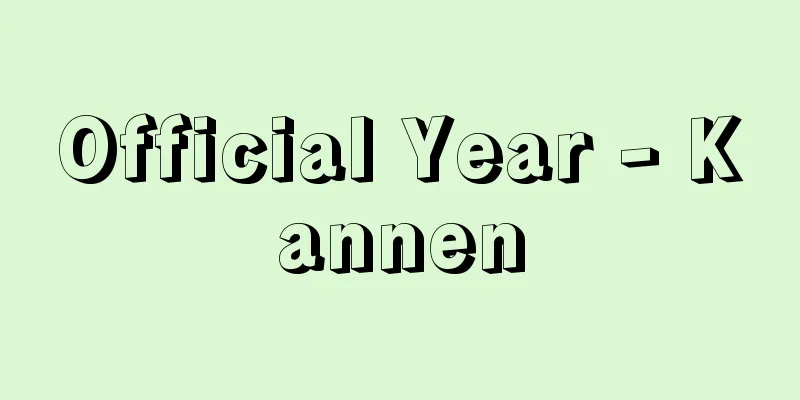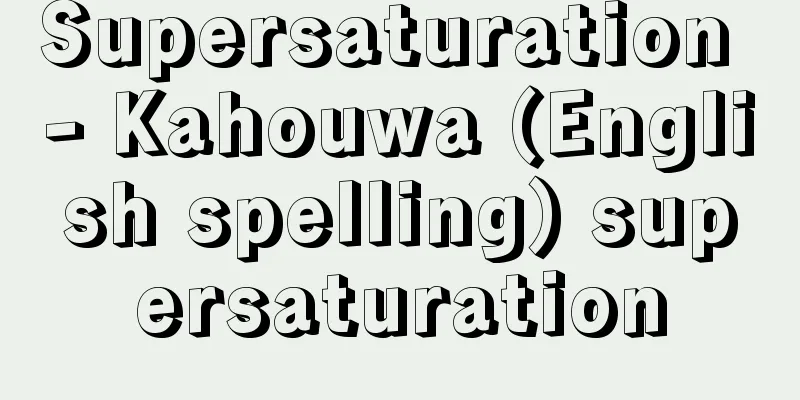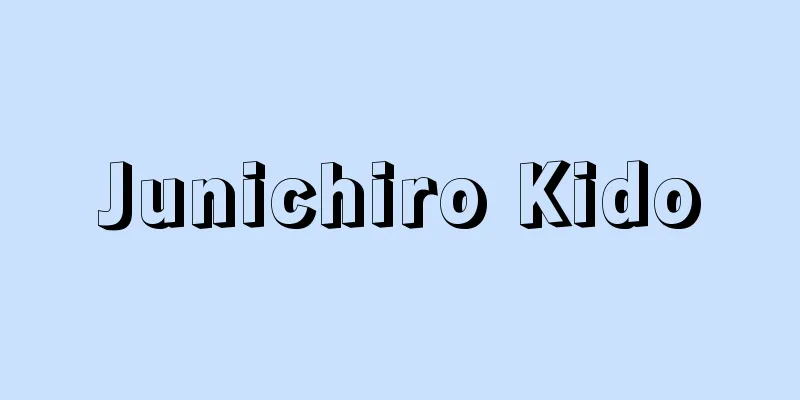Jomon culture
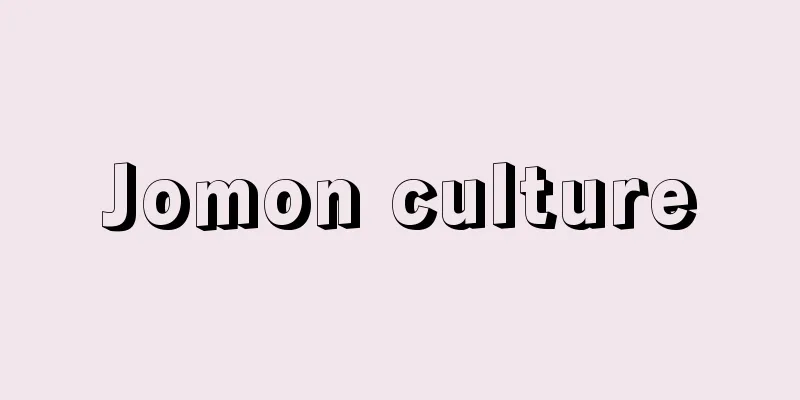
|
The period when Jomon pottery was used is usually called the Jomon period, which is said to have lasted from about 12,000 years ago to about 2,400 years ago. The culture of that period is also called the Jomon culture. [Isamu Okamoto] What is Jomon culture?What distinguishes the Jomon culture from the earlier Pre-Pottery (Paleolithic) culture is the appearance and widespread use of pottery and bows and arrows. There is no clear statement yet as to whether these two tools were native to Japan or were transmitted from other regions. The bow and arrow are hunting tools that appeared in place of spears, and although their structure is simple, they are machines that apply physical principles and have great significance in the history of tools. In particular, the fact that they were projectiles made them more effective at hunting small animals and birds. On the other hand, earthenware was created by consciously utilizing chemical changes in things. By subjecting a soft, plastic lump of clay to fire for a certain period of time, a completely different object called earthenware is created. At first, earthenware was used exclusively as a tool for boiling food. Traditionally, there were two ways to cook food: "eat raw" or "eat roasted," but with the advent of earthenware, a new method of "eat boiled" was added. This expanded the variety and range of foods available, promoting improvements in dietary life. Currently, one of the oldest known pottery is the "pea-shaped pottery" excavated from the Senpukuji Cave in Sasebo, Nagasaki Prefecture. Jomon pottery developed throughout Japan from Hokkaido to Okinawa over the next 10,000 years. The diversity of vessel shapes and patterns makes it unique among Neolithic pottery in the world. Jomon pottery has three characteristics: regionality, commonality, and continuity. In other words, there are regional differences, as if responding to the environment of each region. Broadly speaking, differences can be seen between eastern and western Japan, and it is also possible to point out differences between those in Tohoku and Kanto, and even within the Kanto region itself. However, despite these regional differences, common features can be found that run through each region. In particular, the uniformity of pottery patterns is an indication of the commonality of Jomon culture. Furthermore, strong connections can be traced between pottery from around the same period. Of course, there are discontinuities and gaps, but more than that, there is a continuity. These three characteristics are thought to be a reflection of the Jomon culture itself. [Isamu Okamoto] Distribution of ruins and populationThe total number of Jomon period ruins is not known accurately. It is probably safe to say that there are roughly 100,000 ruins. The reason for the large number of ruins is not simple, but one reason is the large population. It is safe to say that the population density was high compared to the size of Japan's land area. The number of ruins was thought to be overwhelmingly greater in eastern Japan, but as research in western Japan has progressed, the difference has been narrowing. Regarding the population issue, there are opinions that there were "150,000 to 250,000, with a thin presence in the southwest and a large presence in the northeast" (Yamauchi Sugao) and "120,000 in the whole of Japan" (Serizawa Chosuke), but Koyama Shuzo, who made a more detailed estimate, put the figures at "20,000 in the early period, 260,000 in the middle period, and 76,000 in the late period." [Isamu Okamoto] PeriodIn archaeological research, a so-called "chronology" is constructed by setting a "type" based on the characteristics of the pottery's patterns and shapes, and then ordering the relationship between the older and newer types in chronological order. It is customary to name a pottery type after the site where it was first discovered or noticed. For example, the "Kassaka-type pottery" from the middle Jomon period is named after the Kassaka site in Sagamihara City, Kanagawa Prefecture. In the case of Jomon pottery, a chronology of pottery types is created for each region, and a web-like order is being created across Japan. This is the foundation of Jomon culture research. This chronological system is the basic measure for measuring the age of the Jomon period, which did not have written language. In this case, the type can be said to be the small scale of a ruler. The type is also thought to represent the outline of the human group that made and used the pottery. Based on research into Jomon pottery, the long Jomon period is generally divided into five periods: early, early, middle, late, and final. The early period is sometimes divided into two, with the older period being called the incipient period. This division of periods can be likened to the broad divisions on the scale of a ruler. The above-mentioned chronology and division of periods is called relative dating, but in recent years, dating methods that use physicochemical methods such as C-14 dating to determine absolute dates numerically have come into widespread use. According to these, the Jomon period is said to have begun around 12,000 years ago. The Jomon culture developed very slowly, but its trajectory cannot be drawn in a simple straight line. It is a varied upward line marked by many small stages. The accumulation of these small stages makes up the history of the Jomon period. Some of these stages were small and only found in one region, while others were prominent and common to all regions. These serve as suitable indicators for dividing periods. Based on this, it is possible to generalize the history of the Jomon culture into the following stages: Establishment stage ('inception', early), development stage (early, middle), maturity stage (late middle to early late), and terminal stage (late late). Furthermore, based on an examination of various phenomena within the Jomon culture, some have suggested that it should be broadly divided into an early period and a later period. [Isamu Okamoto] Basics of LifeFoodThe Jomon culture was based on a forager economy, centered on hunting, fishing, and gathering plant foods. People relied on the products of nature for their diet. However, there are some theories that suggest primitive agriculture was involved, and that young wild boars were kept for food. [Isamu Okamoto] huntingBows and arrows were widely used as hunting tools. The stone arrowhead is one part of the arrow, and an essential part. It is found in every period and region of the Jomon period, and it supports the development of bows and arrows. Bows were made almost exclusively from wood, but plant-based remains have only been found in limited places such as peat-layer and low-lying marsh sites. About 30 examples are known to have survived to date. Most are round-wood bows, and many are made of Inugayaki. Large and small bows carefully crafted with lacquer have been excavated from the Korekawa site (late period) in Aomori Prefecture. How powerful were bows and arrows with stone arrowheads? A stone arrowhead was once found still embedded in part of a boar bone at the Shijimizuka site (late period) in Hamamatsu City, Shizuoka Prefecture. This indicates that the stone arrowhead had the power to pierce the skin and flesh and reach the bone. Excavations of stone spears (sekisou), which are spear tips, are somewhat prominent in Hokkaido and the Tohoku region, but are rare in the Kanto region, and are limited to the Middle Jomon period or earlier. In Western Japan, apart from special cases, they are virtually nonexistent. There is no doubt that dogs played an important role as hunting dogs. Dog skeletons are often found in shell mounds from the Jomon period. Furthermore, pitfalls were widely used to catch animals. [Isamu Okamoto] fishingThere were three main methods for catching fish: angling, spearing, and using nets. The shapes and types of fishing tools made from antlers, such as fishhooks, harpoons, and spears, excavated from shell mounds are quite diverse, which is partly due to differences in the eras and partly due to their relationship to the ecology of the fish they were targeting. Line fishing and spear fishing are essentially aimed at catching a single fish, and can be done by a single person. To that extent, they are solitary fishing, so to speak, and the fishing equipment used can be described as personal fishing gear. In contrast, fishing with nets is used to catch large quantities of fish at once, and is a much more efficient and sophisticated method compared to individual fishing. Earth and stone weights are indirect indicators of the presence of fishing nets. These are commonly found at coastal ruins, and their number has increased dramatically since the Middle Period. Many fish bones have also been excavated there. [Isamu Okamoto] Collecting plant foodsIt is safe to say that the proportion of plant-based foods in the diet of Jomon people was larger than expected. Plant gathering was already widespread from the very early period, and is a continuation of the tradition from the Pre-Pottery period. Among plant foods, nuts, especially acorns, chestnuts, walnuts, and other nuts, occupied a major position. All of these could be harvested in the fall. No special tools or techniques were required for collection. They were simply picked up and put in a basket. It was easy to collect large quantities. Small flask-shaped (bag-shaped) or U-shaped vertical holes (1 meter deep and 1 meter wide or larger) that are thought to be storage holes have often been found in settlement ruins, mainly from the Middle Period onwards. They are often found in clusters, and charred nuts have been found inside. Regardless of whether they were used for a single purpose, there is no doubt that they were used to store nuts. At the Sakanoshita ruins (Middle Period) in Saga Prefecture and the Minamigata Maeike ruins (Late Period) in Okayama Prefecture, etc., they have been found packed with chestnuts, acorns, and other nuts. In addition to nuts, many other types of plant foods, such as roots and fruits, were used. In the early-period inclusion layer of the Torihama shell mound in Fukui Prefecture, a well-known low-lying marshland site, nuts such as acorns, chestnuts, walnuts, and camellias have been found, along with edible seeds of water chestnuts, silver vine, soapberry, Zelkova, mountain laurel, grapes, and dogwood. However, these have little value as food and could not be used as staple foods. In addition, "cultivated plants" such as gourds and mung beans have been discovered, which is an important finding in relation to the issue of primitive agriculture. Furthermore, a mass of charred bulbs was excavated from the remains of a middle-period pit dwelling at the Kaminoiri site in Hiratsuka City, Kanagawa Prefecture, and this has been determined to be the bulb of the foxglove (a species of amaryllis). In the case of rhizomes, it is difficult for them to remain, so this is a valuable discovery. In reality, it is safe to assume that many more plants, many of which were highly efficient as food, were used for food. For example, Chinese yam would have naturally been collected. In the past, charred bread-like charred matter was excavated from the remains of a pit dwelling at the Sori site (middle period) in Nagano Prefecture, attracting attention. Similar examples were subsequently discovered at sites in Gifu, Fukushima, Iwate, and Niigata prefectures. All of these were from sites belonging to the middle period. It is certain that these were foods made by solidifying and baking starchy powder. It is unclear what kind of powder was used, but it is most likely acorns. The practice of soaking acorns in water to remove the bitterness and grinding them into flour using stone plates and grinding stones must have been widespread from an early stage. It is safe to say that the use of plant foods, mainly nuts and bulbs, was actively carried out from the beginning of the Jomon period. However, the importance of these foods in the diet is thought to have varied depending on the region and the time period. Nevertheless, they played a major role in maintaining a certain balance by complementing other types of foods. Although the gathering of plant foods was seasonal, it was possible to gather large quantities at one time. For this reason, storage became important only when it became possible to plan and organize it. This was probably during the middle stage. [Isamu Okamoto] LivingPit dwellingsThe ground is dug into a fixed plan, walls, floors and hearths are installed, a framework is made of pillars, beams and other structures, and a roof is placed on top. Dwellings constructed in this way, known as pit dwellings, appear to be a form of dwelling that already appeared in the Pre-Pottery period. They continued to be adopted throughout the Jomon period and in various regions, spreading and developing. However, the vast majority of pit dwellings have been found in eastern Japan, and very few in western Japan. This is mainly due to the topographical and soil conditions of the ruins. Early dwelling sites are generally simple in structure. Plan shapes can be broadly divided into two types: those based on a square shape and those based on a circle. There are slight differences in the remains of the hearth and the layout of each part. Known hearth sites include those that were simply a hollow dug into the floor to light a fire (jishoro), those with the lower half of a deep bowl-shaped pottery chipped away and buried (maiyoro), and those surrounded by gravel (ishigumi or ishigakoi). Large, complex hearths (compound hearths) have been discovered, particularly in the remains of dwellings from the middle period in the Tohoku and Hokuriku regions. Some dwelling sites from the middle period onwards have remains that appear to be entrances, and it seems there was a custom of burying intact pottery in these areas or on the floor. It is believed that the remains of infants or placentas were placed inside these. There are also known examples of large stone poles standing near the back wall, and cases where platform-shaped stonework has been left behind. Pit dwellings were not just places to sleep, but were also deeply connected to religious beliefs and rituals. In addition, dwellings called "stone paving dwellings" were built, with large flat stones laid out flat to create the floor. These developed mainly in the mountainous areas of the Kanto and Chubu regions, where stone was easily available. The floor area of a pit dwelling cannot be generalized, but it is usually around 20 to 30 square meters. How many people lived there, or could have lived there? A group of human bones (two adult males and two adult females, and one child) discovered piled up on top of each other on the floor of one pit dwelling site from the end of the Middle Period at the Ubayama shell mound in Chiba Prefecture are known as evidence of the number of people living in the pit dwelling. Since then, several other dwelling sites have been reported in which similar human bones have been excavated. Based on these facts and the general size of the floor, we can infer that the number of people living there was several or so. However, the remains of particularly large pit dwellings have been excavated in parts of the Hokuriku and Tohoku regions. At the Fudoudou site (middle period) in Toyama Prefecture, an oval-shaped pit dwelling measuring 17 meters in length and 8 meters in width, with four stone hearths on the floor, was excavated. Structurally it is not very different from an ordinary pit dwelling, but its area is much larger. Also known from the Sugisawadai site (early period) in Akita Prefecture is an oval-shaped dwelling measuring 31 meters in length and 8.8 meters in width. These particularly large dwellings are thought to be different in character from the average pit dwelling. There are several theories as to what they were, such as a meeting hall-type facility, a type of storehouse or workshop, but these are merely speculations. [Isamu Okamoto] SettlementA group of pit dwellings make up a settlement. In the early period, a settlement with at most two or three houses seems to have been built. However, from the early period onwards, several houses were definitely built in a fixed arrangement around a square. This type of settlement is common in the Jomon period, and the seeds of it appeared already in the early period. Then, as the period progressed from the early to the middle to the late periods, it became more typical and larger. This includes what are called "circular settlements" or "horseshoe-shaped settlements". We will call these "typical settlements". In these settlements, life was carried out for a fairly long period of time, although it is not clear whether it was continuous or intermittent. In terms of pottery, many of them lasted for several types or even longer. As a result, the remains of the dwelling sites became very large, with some numbering in the tens or even hundreds. Of course, this is not the original number of dwellings that made up the settlement. Moreover, overlapping residential sites are noticeable. The square in a typical settlement is a shared facility for the groups that make up the settlement, and is thought to have been an essential place for various production activities and events. The settlement mainly consists of pit dwellings, but in addition to these, special remains known as "rectangular post hole rows" or "post-hole building sites" have been discovered. Post holes of roughly the same size or larger than those in the pit dwelling sites are regularly lined up in a rectangular, oval, or long tortoise shell shape, but no walls, floors, or hearths can be seen. The largest remains are 15 meters in diameter, the smallest about 5 meters. There is almost no doubt that these are the remains of buildings. Along with the particularly large pit dwellings, their nature is unknown, but the fact that such structures existed within typical settlements cannot be denied. Although formal settlements developed after the Early Period, it is clear that small settlements of two or three houses were seen in parallel with these at an early stage. There are also residential sites where no dwelling remains have been found at all. These are considered to be places where people lived in a camp-like style. [Isamu Okamoto] ClothingWhat kind of clothing did the Jomon people wear? In the past, there were comments about the issue of clothing based on the designs of clay figurines, but these discussions ended without any progress. There is a view that animal fur or salmon skin was used. This is quite possible. There are worthy crafts of braiding and knitting using bamboo and vines from the Jomon period, but the existence of definite textiles is unknown. In recent years, the existence of primitive textiles such as angin has been reported. Since textile technology was quite advanced as seen in the original Jomon pottery, if this was combined with weaving techniques, it would be possible to produce textiles for use in clothing. The clothing of the Jomon people may have been of a higher standard than expected. [Isamu Okamoto] Funeral customs and beliefsburialHuman bones have been excavated from Jomon ruins, especially shell mounds. Most of the bodies were buried in a pit just large enough for the remains to fit inside, with their limbs bent in an uncomfortably folded position (flexed burial). Some were buried with their limbs stretched out (extended burial). This extended burial was mainly carried out from the middle Jomon period onwards. Shell mounds, which are a kind of garbage dump, were generally left near dwellings, and the fact that human bones were excavated from shell mounds indicates that the cemetery was located not far from the dwelling. The number of human bones excavated from shell mound cemeteries was small even in the early stages, with only one or two bodies being found at most (however, in the case of cave ruins and rock shelter ruins, a relatively large number of human bones have been excavated. This is the result of the limited location of the burial sites). The number of bones increased from the middle Jomon period onwards, and there are known to be many examples of human bones being found in shell mounds, especially from the later and final Jomon periods. The Yoshigo shell mound in Aichi Prefecture yielded over 300 human bones, the Tsugumo shell mound in Okayama Prefecture yielded 57, and there are several other shell mounds that have yielded over 30. This trend is partly related to the length of residence, but the main reason is that it is proportional to the population size of the group that made up the settlement. In shell mound cemeteries, no facilities are found on the ground where the remains are buried. Originally, there may have been some sort of wooden grave marker. At Yoshiko shell mound and other sites, a burial method is known in which limb bones are arranged in a square shape, with skulls and other remains placed inside (a slab-shaped accumulation burial). This is a kind of reburial, in which old human bones that happened to be unearthed when new remains were buried were arranged in an orderly fashion, rather than in a chaotic manner. Cases in which multiple remains were buried at the same time, i.e., joint burials, have also been found in shell mounds around the country. The relationships between the remains buried together are not consistent, and there are cases of males and females, or of the same sex, and there are also known cases of elderly people and children. A joint burial should be considered as a burial of people who died at the same time or around the same time. In addition, 15 human bones were found lined up in a large pit just over 2 meters long at the Miyamotodai shell mound (late period) in Chiba Prefecture, and this is a rare example that is attracting attention. Burial pits are often found in ruins other than shell mounds. Some are known to still contain traces of human remains. There are graves with several stones arranged in a regular pattern on the ground surface, known as stone-arranged tombs. Many of these graves are grouped together to form a fixed burial area. Arrangements of stones marking graves appeared in the middle period, but they did not become widespread or developed until the later period. In addition to the pits, some have magnificent stone coffins made of flat stones, which adds to the structural complexity. In Hokkaido, magnificent graveyards known as stone-circular tombs and earthen tombs (circular fence tombs) were built. These graveyards are characterized by their abundance of grave goods and the fact that they are located far from settlements, making them particularly unique. [Isamu Okamoto] Burial in a jar and washing the bonesOne funeral custom that should not be forgotten is the jar coffin. The remains were placed in a large, deep, pot-shaped earthenware vessel that was used daily, but since there were no large earthenware vessels in the Jomon period that could hold the remains of an adult, the objects of burial were limited to fetuses, infants, and small children. This is why they are called children's jar coffins. Looking at the 10 jar coffins discovered at the Numazu shell mound (late/late period) in Miyagi Prefecture, 9 contained premature or stillborn infants, and 1 contained an infant just after birth. In addition, more than half of the 35 jar coffins found at the Yoshigo shell mound (late/late period) in Aichi Prefecture contained fetal bones, and some contained the bones of children between the ages of 3 and 6. In addition, children's jar coffins have been discovered in many archaeological sites from the late and late periods. This is not unrelated to the high child mortality rate in the Jomon period. Among the jar coffins, there are some that contain adult human bones, although the number is not large. In these cases, the remains were buried after being washed, indicating that the custom of washing bones existed during this period. An example from the Tengutai site (late period) in Aomori Prefecture has been reported since ancient times, but similar cases have since increased. There are also known traces of cremation, which shows that Jomon period funeral practices were not simple. However, even if the tombs and their funeral practices were diverse and complex, this was a phenomenon that occurred within a certain framework, and does not represent the existence of special individuals or classes that transcend the communal relationships of Jomon society. [Isamu Okamoto] Magic and faithClothing accessories are sometimes found with buried human bones, or simply within pits. They are a type of accessory worn in life, but they also have a great deal of magical significance. They include hair ornaments (combs, hairpins), earrings, necklaces, bracelets, rings, and waist ornaments, and are made from a variety of materials. Among these, shell bracelets (shell rings) and deer antler waist ornaments are relatively prominent. Shell rings are made by drilling holes in large bivalve shells such as cranes and ark shells, which are then polished. Waist ornaments are made from the forks of deer antlers, and are elaborately carved and intricately processed. They are so named because they are found mainly near the waist of human bones. These are not simply decorative items, but are filled with ritual significance. The majority of human bones wearing shell rings are female, but waist ornaments are almost always found with male bones. The presence or absence of clothing accessories and the amount of clothing they possess are thought to be closely related to gender and age, rather than differences in social status or rank. Some human bones show evidence of tooth extraction, which is when a certain number of incisors or canines were intentionally removed during the individual's lifetime. The method of extraction varies slightly depending on the period. Tooth extraction was prevalent throughout Japan mainly from the Late to Final Period (and in some cases even into the Yayoi Period), and is thought to have been a custom carried out during ceremonies such as coming-of-age ceremonies. There are also specimens known as forked teeth. These are incisors that have been deformed into a shape similar to a fork by making two incisions, a fairly elaborate surgical procedure. One of the characteristic relics of the Jomon period is the clay figurine. They have appeared since the early period, and the example excavated from the Hanawadai shell mound in Ibaraki Prefecture is a small figurine measuring 4 to 5 centimeters in length. It has no facial features, but has breasts and can be identified as a woman. There are various shapes of clay figurine, such as plate-shaped clay figurine (early and middle periods), cylindrical clay figurine, three-dimensional clay figurine with legs, mountain-shaped clay figurine, owl clay figurine (late period), and sunshade clay figurine (late period). Most of them are female figures, and many of them have swollen abdomens. It is thought that clay figurines were not toys or ornaments, but were deeply connected to the spiritual life of the Jomon people. It is extremely rare for clay figurines to be discovered in their entirety, and most are missing some part. There are examples where the missing parts have been glued back together with asphalt. There are also clay tablets and rock tablets, which many believe to be a kind of amulet. In addition, non-practical relics such as stone clubs, stone swords, and stone knives are interpreted as baton or symbol of authority. The existence of clay masks cannot be ignored. [Isamu Okamoto] TechnologyWoodworkingAmong the technologies of the Jomon period, some of the most notable and distinctive are woodworking techniques and the use of lacquer and asphalt. Wood was used in many aspects of life, including as a building material for homes. Despite the limitation that the basic tools were stone tools, a fairly high level of technology was maintained, making it possible to produce a wide variety of wooden utensils and products. Known facilities and tools made from wood include fishing devices, bridges (wooden walkways), dugout canoes, oars, bows, stone axe handles, containers such as shallow bowls, trays, and bowls, and accessories such as combs and bracelets. Large logs with a diameter of several tens of centimeters were chosen for the pillars of the cannon and giant dwellings. Polished stone axes were mainly used for cutting these. The stone axes were double-edged (vertical axes), and parallel handles were attached. From the Torihama Shell Mound (early period), many refined handles made of flexible tree species such as Sakaki and camellia, as well as many unproducts of these. The vertical axes played the main role in cutting and breaking processes, but single-edged stone axes (horizontal axes) are functionally suitable for cutting. Stone cones and stone blades were used for drilling holes and processing details. In addition to stone tools, burning and cutting by fire was widely used when cutting and cutting. It is also known that pumice stones were used to smooth the surface during the finishing stage. When making wooden vessels, the appropriate species are selected. The bows are cays and zelkova, and the containers are zelkova and zelkova and zelkova. It is also known that a broken deep bowl is joined with deer antler nails with both ends pointed (Torihama Shell Moss). This is also proof that wooden vessels were treated preciously. [Isamu Okamoto] Utilization of lacquerThe fact that lacquer was used as a paint during the Jomon period was known early on in the artifacts excavated at the Kamegaoka Ruins in Aomori Prefecture and Korekawa Ruins (both late). However, since then, materials from various regions (Hokkaido to Kinki) were gradually discovered at various times (except early), and it was thought that the use of lacquer was more common than expected. Relics painted with lacquer include wooden containers such as bowls and takatsuki, decorative bows and combs, and some refined earthenware also have partially painted lacquer. There are two types, vermilion and black, but the use of vermilion is higher. In some cases, both are used in combination, or some of them represent patterns. In addition, lantaishiki, made by applying lacquer to a type of basket woven with bamboo, etc., is considered to be one of the characteristic relics of the Jomon period. [Isamu Okamoto] asphaltNatural asphalt produced in Akita Prefecture was used as a kind of adhesive after and late in the Jomon period, in eastern Japan, especially in the Tohoku region. There have been cases where asphalt has been attached to various stone and bone horns, such as stone arrowheads, bone hornheads, root shears, hornheads, and stone hornheads. These are the result of asphalt being used as an adhesive and fixative when worn or worn. Similar examples are also known at sites where clay figurines have been broken. At the Korekawa Ruins (late period), asphalt was once found in small earthenware, still solidified. Apparently it was intended to melt with heat. [Isamu Okamoto] The influence of continental cultureになったんです。 English: The first thing you can do is to find the best one to do. The so-called ketsujo earrings are one of the most representative body ornaments of the Jomon period, and were used in various places from the early end to the middle period. There has been a long time ago that this is related to the Chinese "green," but in recent years it has become a problem with the same species of the Neolithic period. [Isamu Okamoto] "Kondo Yoshiro et al., "Iwanami Lectures, Japanese Archaeology," 9 volumes (1985-1986, Iwanami Shoten)" ▽ "Kato Shinpei et al., "Study on Jomon Culture," 10 volumes (1981-1984, Yuzankaku Publishing)" ▽ "Jomon Pottery Taisei," 5 volumes (1981-1982, Kodansha)" ▽ "Kamaki Yoshimasa, Japanese Archaeology II, Jomon Period" (1965, Kawade Shobo Shinsha)" ▽ "Koyama Shuzo, Jomon Period (Chuokoron Shinsho)" [Reference items] | | | | | Bendary | | | Stone Weight | | Pit Dwelling | Pottery | Clay Dog | Earthenware | Earthenware | Earthenware | Earthenware | Earthenware | Earthenware | Earthenware | Earthenware | Earthenware | Earthenware | Earthenware | | Earthenware | | Earthenware | | | Earthenware | Earthenware | Earthenware | | Earthenware | | Earthenware |Source: Shogakukan Encyclopedia Nipponica About Encyclopedia Nipponica Information | Legend |
|
縄文土器の使われた時代を、普通、縄文時代とよんでおり、その時期は1万2000年前ごろから2400年前ごろまでとされている。また、その時代の文化を縄文文化と称している。 [岡本 勇] 縄文文化とは縄文文化が、それ以前の先土器(旧石器)時代文化と画然と区別される点は、土器と弓矢の出現普及にある。この二つの道具が、日本の土地で自生したものであるか、他地域からの伝播(でんぱ)によるものであるかについては、まだ明確な発言を聞くまでには至っていない。 弓矢は、槍(やり)にかわって登場した狩猟具であるが、その構造が単純であるとはいえ、物理的な原理を応用した器械であり、道具の歴史からみて、大きな意義をもっている。とりわけそれが飛び道具であったことは、小形動物や鳥類に対する狩猟効果を高めることとなった。 一方、土器は物の化学変化を自覚的に利用することによってつくりだされた。柔らかくて可塑性のある粘土塊に、一定の時間火熱を加えることによって土器というまったく別の物体が生まれるのである。初め土器はもっぱら食物を煮炊きする道具として使われた。従来、食物の調理には「生(なま)で食べる」「焼いて食べる」の二つの方法があったが、土器の出現によって「煮て食べる」という新しい方法が加わった。このことは食料の種類と範囲を拡大し食生活の向上を促した。 現在、さかのぼりうる最古の土器の一つとして、長崎県佐世保(させぼ)市泉福寺(せんぷくじ)洞穴出土の「豆粒文(とうりゅうもん)土器」があげられている。縄文土器は、このあと約1万年もの長い年代にわたって、北海道から沖縄にかけての日本全土で発達した。器形や文様の多様なあり方は、世界の新石器時代の土器のなかでも、特異な存在とみなすことができる。 縄文土器には、地域性、共通性、連続性の三つの性格が備わっている。つまり、それぞれの地域の環境に対応するかのように、地域ごとの差をもっている。大きくは、東日本と西日本との間の違いが認められるし、また、東北と関東のものとの差、さらには関東内部での違いを指摘することも可能である。しかし、こうした地域性の反面、各地域を貫く共通の特徴がみいだされる。とくに土器文様の斉一性は、縄文文化の共通性の表れである。また、年代的に前後する土器相互の間には、強いつながりをたどることができる。もちろん断続や空隙(くうげき)もみられはするが、それ以上に連続性を保っているのである。この三つの性格は、縄文文化そのものの反映であると考えられる。 [岡本 勇] 遺跡分布と人口縄文時代の遺跡の総数は、正確には把握されていない。概数はおそらく約10万か所といってよいであろう。遺跡数の多いことは、単純にはいえないが、一つには人口の多かったためである。日本の国土面積に比較して、人口密度は高かったとみてよい。遺跡数は、東日本に圧倒的に多いとされてきたが、西日本での調査が進行するなかで、その差は縮まってきた。人口の問題について、「15万から25万、西南に薄く、東北に多い」(山内清男(すがお))、「日本全体で12万人」(芹沢(せりざわ)長介)という見解があるが、よりきめの細かい推算をした小山修三は「早期2万、中期26万、晩期7万6000」という数字を見積もっている。 [岡本 勇] 時期区分考古学研究のうえでは、土器の文様や形などの面にみられる特徴をもとに「型式」を設定し、各型式相互の新旧関係を年代順に秩序づけることによって、いわゆる「編年」が組み立てられている。土器型式は、それが最初に発見・注意された遺跡の名を冠してよぶのが習わしである。たとえば、縄文時代中期の「勝坂(かっさか)式土器」は、神奈川県相模原(さがみはら)市勝坂遺跡の名にちなんでいる。縄文土器の場合には、各地域ごとに土器型式の編年がつくられ、日本全土にわたる網の目のような秩序ができあがりつつある。これは、縄文文化研究の土台をなしている。この編年体系は、文字のなかった縄文時代の年代を測る基本的な尺度となるものである。その場合、型式は物差しの小さな目盛りとでもいうことができる。また別に、型式は、その土器をつくり、使った人間集団の輪郭を表していると考えられる。 長い縄文時代は、縄文土器の研究に基づいて、普通、早期、前期、中期、後期、晩期の五つの時期に大別されている。また、早期を二分して、古いほうを草創期とよぶこともある。この時期区分は、物差しの目盛りの大きな区分けに例えることができる。前記のような編年と時期区分は相対年代とよばれるが、近年ではC‐14年代法など理化学的方法によって数値で絶対年代を求める年代決定法が多く用いられるようになった。これらによれば縄文時代の開始は1万2000年前ごろといわれる。 縄文文化は、きわめて緩やかな発展をたどってきたが、しかしその軌跡は、単純な直線で描かれるようなものではない。たくさんの小さな段階を画しながら、変化に富んだ上昇線を表してきたのである。こうした小さな段階の累積が、縄文時代の歴史を形づくっている。これらの段階のなかには、一地域にのみ認められる小規模なものもあるし、また各地域を貫いて共通に認められる顕著なものもある。これらは時期区分の指標としてふさわしい意味をもっている。これに立脚して、縄文文化を歴史的に概括すると、次のような段階区分が可能である。 成立段階(「草創期」・早期)、発展段階(前期・中期)、成熟段階(中期末~晩期前半)、終末段階(晩期後半)。 また、縄文文化の諸現象の検討から、大きく前半期と後半期に二分する意見もある。 [岡本 勇] 生活の基礎食縄文文化は、狩猟、漁労、植物性食料の採集を中心とする採集経済のうえに立脚する。人々は、自然の産物に食生活をゆだねていたのである。しかし、原始的な農耕があったとする考えや、イノシシの幼獣の飼食などが行われていたという見解が聞かれる。 [岡本 勇] 狩猟狩猟の道具として広く一般的に使用されたのは弓矢である。石鏃(せきぞく)は矢の一部分であり、しかも不可欠の部分である。縄文時代の各時期・各地域にわたって認められ、弓矢の発達を裏書きしている。弓はもっぱら木でつくられたが、植物質の遺物は泥炭層遺跡や低湿地遺跡のような限られた場所でしか発見されない。遺存例は、いままでに30例ほど知られている。大部分は丸木弓であり、イヌガヤ製が多い。青森県是川(これかわ)遺跡(晩期)からは、漆塗りの入念に加工した大小の弓が出土している。石の鏃(やじり)をつけた弓矢の威力は、どの程度のものであったろうか。かつて静岡県浜松市蜆塚(しじみづか)遺跡(後期)から、イノシシの骨の一部に石鏃が射込まれたままのものが発見されたことがある。これは、石鏃が皮と肉を貫いて骨にまで達する威力をもっていたことを示している。 槍先である石槍(せきそう)の出土例は、北海道・東北地方ではやや目だつが関東地方ではまれで、しかも中期以前に限られる。西日本では特殊なものを除けば皆無といってよい。またイヌが猟犬として大きな役割を担ったことは疑いない。縄文時代の貝塚からはイヌの骨格がしばしば発見される。さらに、動物を捕まえるのに落し穴の利用も盛んに行われた。 [岡本 勇] 漁労主として魚類の捕獲には三つの方法があった。釣ること、突き刺すこと、網を使うことである。 貝塚から出土する釣り針、銛(もり)、あるいはやすなどの鹿角(ろっかく)製漁労具の形や種類は、かなり多様であるが、それは一つには年代差によるものであり、また一つには対象とする魚類の生態との関係に基づくものである。 釣り漁や突き漁は、本来1匹の獲物を対象とし、単独でも行うことができる。その限りでは、いわば単独漁であり、その道具は個人的漁労具ということができる。これに対し、網による漁労は多量の魚をいちどきに捕獲するものであり、個人漁に比較すれば、はるかに能率的で高度の漁法である。漁網の存在を間接的ながら示すものとして、土錘(どすい)・石錘がある。これらは沿岸部の遺跡で一般的に発見され、とくに中期以降急増する。そこでは魚骨の出土も多い。 [岡本 勇] 植物性食料の採集縄文時代人の食生活のうえで植物性食料の採集が占める割合は、予想以上に大きかったとみてよい。植物採集は、すでに早期の初頭から広く行われており、これは先土器時代からの伝統を継ぐものである。 植物性食料のなかで主要な位置を占めるものは、木の実類、とりわけどんぐり、クリ、クルミなどの堅果類であった。これらはいずれも秋の季節に収穫できる。その採集には、とりたてて道具も技術も必要としない。拾い集めて籠(かご)に入れる。簡単に大量に採集できるわけである。主として中期以降の集落遺跡からは、貯蔵穴とみられる断面フラスコ形(袋状)ないしはU字形の小竪穴(たてあな)(深さ、径ともに1メートル、またはそれ以上の大きさ)が、しばしば発見される。しかも群在している場合が多く、中から木の実の炭化したものがみつかったりする。単一の目的のものであったかどうかは別として、木の実類の貯蔵に使用されたことは間違いない。佐賀県坂の下(さかのした)遺跡(中期)、岡山県南方前池(みなみがたまえいけ)遺跡(晩期)などからは、内部にぎっしりとクリやどんぐりなどの堅果が詰まったままの状態で発見されている。 堅果類のほかに、なお多くの種類の植物性食料、たとえば根茎類や果実が利用された。低湿地性遺跡として有名な福井県鳥浜(とりはま)貝塚の前期の包含層からは、どんぐり、クリ、クルミ、ツバキなどの堅果とともに、ヒシ、マタタビ、ムクロジ、ムクノキ、ヤマボウシ、ブドウ、クマノミズキなどの食用になりうるものの種子が検出されている。しかし、これらは食料としての価値は低く、主食とはなりえないものである。また、ヒョウタン、リョクトウ(緑豆)などの「栽培植物」が発見され、原始農耕の問題とも関連して重要な所見となっている。さらに神奈川県平塚(ひらつか)市上ノ入(かみのいり)遺跡の中期の竪穴住居址(し)内から、炭化した状態の球根が固まって出土したが、これはキツネノカミソリ(ヒガンバナ科の1種)の球根であると判定されている。根茎類の場合には、遺存しにくいという問題があり、その意味でこれは貴重な発見である。実際には、もっと多くの、しかも食物として効率の高いものが食用に供されたと考えてよい。たとえばヤマノイモなどは、当然採集の対象とされていたであろう。 かつて、長野県曽利(そり)遺跡(中期)の竪穴住居址内から、黒焦げになったパン状の炭化物が出土し、注目を集めたことがある。その後、類例が岐阜、福島、岩手、新潟の各県下の遺跡で発見されるに至った。いずれも中期に属する遺跡からである。これらはデンプン質の粉を固めて焼いた食品であるとみて間違いない。何の粉を利用したかは不詳であるが、多分に考えられるのはどんぐり類である。どんぐりを水にさらしてあく抜きし、石皿と磨石(すりいし)を用いて製粉することは、早い段階から広く行われていたであろう。堅果類、球根類を中心とする植物性食料の利用は、縄文時代の初めから積極的に行われてきたとみてよい。しかし、それが食生活のうえで占める位置は、地域によって、または時期によってウェイトを異にしていたと考えられる。にもかかわらず、他の種類の食料との相互補完のもとに一定のバランスを維持しつつ食生活を大きく支えていたのである。植物性食料の採集は季節的に限定されるが、いちどきに大量の採集が可能である。それだけに貯蔵が計画的・組織的に行われるようになって初めて大きな意味をもつに至る。おそらく中期の段階のことであろう。 [岡本 勇] 住竪穴住居一定の平面形(プラン)に地表を掘り下げて、壁や床、炉などを設け、さらに柱・梁(はり)その他による骨組をつくり、屋根を架ける。このようにしてつくられた住居、つまり竪穴住居は、すでに先土器時代に出現した住居形態のようである。引き続き縄文時代にも各時期・各地方を通じて採用され、普及・発展を遂げた。しかし、竪穴住居の発見例は、東日本に圧倒的に多く、西日本ではきわめて少ない。これは主として遺跡の地形的・土壌的条件によるものである。なお、早期段階の住居址は概して構造が簡単である。平面形は「方」を基本とするものと、「円」を基本とするものの二つに大別される。炉址や各部分のあり方には若干の違いが認められる。炉址には、単に床面を掘りくぼめて火を焚(た)いただけのもの(地床炉(じしょうろ))、深鉢(ふかばち)形土器の下半部を打ち欠いて埋めたもの(埋甕(まいよう)炉)、礫(れき)で周りを囲んだもの(石組(いしぐみ)炉、石囲(いしがこい)炉)などが知られている。また、東北・北陸地方のとくに中期の住居址内からは、大形で造りの複雑なもの(複式炉)が発見されている。中期以降の住居址には、入口部と考えられる遺構をもつものがあり、しかもその部分や床面に完全な形の土器を埋めるという風習があったらしい。この中に乳児の遺骸(いがい)や胎盤などを入れたとする見解がある。また、奥壁付近に大形の石棒(せきぼう)を立てた例や、壇状の石組を残した場合も知られている。竪穴住居は単に寝起きの場であっただけではなく、信仰・祭祀(さいし)にも深くかかわっていた。さらに、扁平な大きな石を平らに並べて床面とした「敷石(しきいし)住居」とよばれているものなどもつくられた。これは、石材の入手に有利な関東・中部地方の山間部に主として発達した。 竪穴住居の床面積は、一概にはいえないが、20~30平方メートル前後の大きさが普通である。ここにどれだけの数の人間が住んでいたのか、あるいは住みうるのか。千葉県姥山(うばやま)貝塚の中期末の一竪穴住居址の床面から、折り重なるような状態で発見された人骨群(男女成人各2、子供1)は、竪穴住居の居住人員を示す資料として知られている。その後、同様な遺存人骨を出土した住居址がいくつか報告されるに至った。これらの事実や床面の一般的な大きさから推して、数人またはその前後の居住人員を考えることができる。 しかし、北陸地方や東北地方の一部からは、特別大形の竪穴住居址が発掘されている。富山県不動堂(ふどうどう)遺跡(中期)の場合は、小判形のプランをもつ長径17メートル、短径8メートル、床面に四つの石組炉をもつものが出土している。構造的には竪穴住居一般と大差ないが、面積ははるかに大きい。また、秋田県杉沢台遺跡(前期)からは、同じく小判形であるが長径31メートル、短径8.8メートルの例が知られている。これらの特別大形の住居は、平均的な竪穴住居と性格を異にするものと思われる。集会所的な施設、一種の倉庫または作業場など、いくつかの考えがあるが、推測の域を出るものではない。 [岡本 勇] 集落竪穴住居は、いくつかが集まって集落を構成している。早期の段階には、せいぜい2、3戸から1集落がつくられていたようである。しかし、前期以降には確実に、数戸内外の住居が広場を囲んで一定の配置をもってつくられる。このようなあり方の集落は縄文時代に普遍的なものであり、すでに早期段階に萌芽(ほうが)的なものが現れる。そして、前期、中期、後期と時期を経るごとに定型的となり、かつ大型化する。「環状集落」あるいは「馬蹄(ばてい)形集落」などとよばれているものは、これに含められる。これを「定型的集落」とよんでおく。この集落では、継続的か断続的かは明確でないが、かなり長期にわたって生活が営まれた。土器でいえば、数型式あるいはそれ以上の存続期間に及ぶものが多い。その結果残された住居址はいたって多くなり、何十、何百を数えるものさえある。もとより、これは集落を構成する本来の住居数ではない。また重複する住居址が目だつ。定型的集落の広場は、集落を構成する集団の共有の施設であり、各種の生産活動や行事の必須(ひっす)の場であったと考えられる。 集落を構成する主体として竪穴住居址があるが、このほかに「長方形柱穴列」あるいは「掘立て柱建物址」とよばれる特殊な遺構が発見されている。竪穴住居址内の柱穴とほぼ同程度かそれ以上の規模の柱穴が、長方形または小判形、あるいは長めの亀甲(きっこう)形に規則的に並んだものであるが、壁・床・炉などはみられない。遺構の大きなものは長径15メートル、小さなものは5メートルほどである。これが建物の跡であることは、ほぼ間違いない。特別に大形の竪穴住居とともに、その性格は不詳であるが、しかし、定型的集落内にこうした建築物が存在していたという事実は、否定すべくもない。 なお、定型的集落が発達したのは前期以降であるが、これと併行して早期の段階にみられた2、3戸規模の小集落があったことも明らかである。また、まったく住居址の発見されない居住址も存在する。これは、キャンプ的な生活が行われた場所とみなされている。 [岡本 勇] 衣縄文人はどのような衣服をまとっていたのか。古くは土偶の意匠から衣の問題についての発言もあったが、なんらの進展もなく終わった。獣の毛皮やサケの皮を利用したという見解が聞かれる。その可能性は十分に考えられる。縄文時代には竹やつるを用いた組物・編物には工芸的にもみるべきものがあるが、しかし確たる織物の存在は知られていない。近年、アンギンのような原始的な織物の存在が報告されるに至った。縄文土器の原体にみられるように繊維技術はかなり発達していたから、これと織り方が結合すれば、衣服に用いる織物の生産は可能である。縄文人の衣服は予想を超える水準のものであったかもしれない。 [岡本 勇] 葬制と信仰埋葬縄文時代の遺跡、とくに貝塚からは、埋葬された人骨が出土する。その多くは、手足を窮屈に折り曲げた姿勢で、遺骸がやっと入る程度の大きさの土壙(どこう)に埋められたもの(屈葬)である。なかには、手足を伸ばしたままの状態で葬られること(伸展葬)もあった。この伸展葬はもっぱら中期以降に行われた。一種のごみ捨て場である貝塚はおおむね住居の近くに残されたものであるが、その貝塚から埋葬人骨が出土するという事実は、墓地が住居からほど遠からぬ位置にあったことを示すものである。貝塚墓地から出土する人骨の数は、早期の段階にはいたって少なく、せいぜい1、2体が発見される程度である(しかし、洞穴遺跡や岩陰遺跡の場合には、やや多数の人骨が出土している。これは埋葬地が場所的に限定される結果である)。中期以降にはその数も増え、とくに後・晩期の貝塚からは、多量の人骨の発見例が知られている。愛知県吉胡(よしご)貝塚からは300体以上、岡山県津雲(つぐも)貝塚では57体、ほかに30体以上の人骨を出土した貝塚がいくつかある。こうした傾向は、一つには、居住期間の長さに関係をもつが、おもな理由は集落を構成する集団の人口量に比例してのことである。 貝塚墓地の場合、遺骸の埋葬された地表には、なんらの施設もみいだされない。本来は、木製の墓標のようなものがあったかもしれない。吉胡貝塚その他では、四肢骨を方形に並べ、その中に頭骨などを置いた葬法(盤状集積葬)が知られている。これは、新しい遺骸の埋葬の際にたまたま掘り出された古い人骨を雑然とではなく規則的に配列したものであり、いわば一種の改葬である。また複数の遺骸が同時に埋葬されたケース、つまり合葬は、各地の貝塚で発見されている。合葬された遺骸相互の関係は一定ではなく、男女の場合も同性の場合もあるし、また老人と子供という例も知られている。合葬は、同時または相前後して死亡したものをいっしょに葬ったものと考えるべきである。なお、千葉県宮本台貝塚(後期)の長さ2メートル強の大きな土壙内からは、15体の人骨が集中的に並んだ状態で発見されたことがあるが、希有(けう)な例として注目される。 貝塚以外の遺跡から、埋葬用の土壙がしばしば検出される。なかには遺骸の痕跡(こんせき)をとどめている例も知られている。地表には、いくつかの石を規則的に置いたものがあり、配石墓の名でよばれている。配石墓の多くは群在し、一定の墓域を形成している。墓としての標識を示す配石は中期の段階に現れるが、普及発達をみるのは後期に入ってからである。土壙とは別に、扁平な石を組み合わせたりっぱな石棺をもつものもあり、構造的に複雑さを増す。北海道には、環状列石墓や周堤墓(環状土籬(どり))などの名でよばれるりっぱな墓地がつくられる。これらは豊富な副葬品を有し、さらに集落から離れた場所に墓地が選定されるなど、その特異さが目だつ。 [岡本 勇] 甕棺葬と洗骨葬法のうえで忘れてはならないものに甕棺(かめかん)葬がある。日常使用されていた大きな深鉢形の土器の中に遺骸を入れて葬るわけであるが、縄文時代には成人の遺体がそのまま入るような大形の土器は存在しないから、対象はもっぱら胎児、乳児、幼児に限定されざるをえない。小児甕棺とよばれるゆえんである。宮城県沼津貝塚(後・晩期)で発見された10例の甕棺についてみると、9例が早産児および死産児を、1例が生後まもない乳児を納めたものであった。また、愛知県吉胡貝塚(後・晩期)の35例の甕棺は、その半数以上が胎児骨の入ったもので、ほかに3歳から6歳ぐらいの幼児骨を葬ったものもあったといわれる。そのほか、小児甕棺は後・晩期の多くの遺跡で発見例が知られている。このことは、縄文時代に小児の死亡率の高かったことと無関係ではない。なお、甕棺のなかには、数こそ多くはないが、成人の人骨の入ったものがある。これは遺骸を洗骨にしてから納めたもので、この時代に洗骨の風習のあったことを示している。青森県天狗岱(てんぐたい)遺跡(後期)の例は古くから報告されていたが、その後、類例は増加している。また、火葬の行われていた痕跡も知られており、縄文時代の葬法は単純なものではなかったことを教えてくれる。しかし、墳墓やその葬法が多様であり複雑であったとしても、それは一定の枠内での現象であり、縄文時代社会の共同体的な関係を超える特別の個人や階級の存在を表すものではない。 [岡本 勇] 呪術・信仰埋葬人骨に伴って、あるいは単に土壙内から、ときおり服飾品が発見される。生前身に着けていた一種の装身具であるが、呪術(じゅじゅつ)的な意味を多分にもつものである。髪飾り(櫛(くし)、かんざし)、耳飾り、首飾り、腕輪、指輪、腰飾りなどがあり、各種の材料でつくられている。これらのうち、貝製の腕輪(貝輪)と鹿角(ろっかく)製の腰飾りの出土が比較的目だつ。貝輪は、ベンケイガイ、アカガイなどの大形の二枚貝に孔(あな)をあけ、順次磨きあげたものである。また、腰飾りは、鹿角の叉(また)の部分を利用し、入念な彫刻や複雑な加工を施したもので、もっぱら人骨の腰部付近から出土するので、この名がある。これらは単なる装飾品ではなく、儀礼的な意味のこもったものである。貝輪を着用した人骨の大部分は女性であるが、腰飾りは男性人骨に伴った例がほとんどである。服飾品の有無や多寡は、身分差や地位の違いではなく、性別や年齢に深い関係があると考えられる。 いくつかの人骨には抜歯が認められる。これは、生前に一定の数の門歯や犬歯を意図的に抜いたものである。その抜き方には時期による若干の変化がみられる。抜歯はおもに後期から晩期にかけて(一部は弥生(やよい)時代にも及ぶ)日本各地に流行したが、これは成年式のような儀式の際に行われた風習とみられている。また、叉状研歯(さじょうけんし)とよばれているものがある。門歯に2本の切り込みを施してフォークのように変形加工したものであるが、かなり手のこんだ外科的手術である。 縄文時代の特徴的な遺物の一つに土偶がある。早期の古い時期から出現しており、茨城県花輪台(はなわだい)貝塚の出土例は、全長4、5センチメートルの小形のもので、顔面は表現されていないが、乳房をつけており、女性と識別できる。板状土偶(前・中期)、筒形(つつがた)土偶、有脚立体土偶、山形土偶、みみずく土偶(後期)、遮光器(しゃこうき)土偶(晩期)など、各種の形状のものが存在する。ほとんど女性像で、しかも腹部が膨らんでいるものが多い。土偶は玩具(がんぐ)や飾り物などではなく、縄文人の精神生活に深いかかわりをもつものであったと考えられる。土偶は完全な形で発見される場合はきわめて少なく、たいていどこかの箇所が欠損している。その欠けた箇所をアスファルトで接着している例がみられる。 ほかに土版、岩版などがあり、一種の護符(ごふ)とみる意見が多い。また、石棒、石剣、石刀などの非実用的な遺物は、指揮棒、権威のシンボルなどという解釈がある。土製仮面の存在も無視できない。 [岡本 勇] 技術木工縄文時代の技術のなかで、とくに注目される特徴的なものに、木工技術、漆とアスファルトの利用などがある。 木材の利用は、住居の建築材をはじめ、生活の各方面にわたっていた。基本的な工具が石器であるという限界をもちながらも、かなり高い技術的水準を保持し、多くの木器・木製品の生産を可能とした。木材を利用した施設や道具としては、魞(えり)(魚をとる装置)、橋(木道)、丸木舟、櫂(かい)、弓、石斧柄(せきふえ)、浅鉢・盆・椀(わん)などの容器類、櫛・腕輪などの装身具類その他が知られている。 丸木舟や巨大住居の柱には、径数十センチメートルの大きな原木が選ばれた。これらの伐採にはもっぱら磨製石斧が用いられた。石斧は両刃(縦斧)で、それと並行する柄がつけられた。福井県鳥浜貝塚(前期)からは、サカキ、ツバキなどの柔軟な樹種でつくられた精巧な柄と、その未製品が多数出土している。切る・割るという工程では縦斧が主役を果たしたが、削るのには機能的には片刃石斧(横斧)のほうが適している。孔をあけたり、細部の加工には石錐(せきすい)・石刃などが用いられた。石器のほかに、火で焦がして削るという方法が、丸木舟を刳(えぐ)る際などに広く行われた。また、仕上げの段階で表面を平滑にするのに軽石を利用したことが知られている。 木器の製作にあたっては、それに適した樹種を選択している。弓にはカヤ、イヌガヤ、容器類にはケヤキ、トチノキといったぐあいである。なお注意されるべきものとして、割れた深鉢を、両端をとがらせた鹿角製の釘で接合するという例が知られている(鳥浜貝塚)。木器が貴重に扱われていた証拠でもある。 [岡本 勇] 漆の利用縄文時代に漆が塗料として使われていたことは、青森県亀ヶ岡遺跡や是川(これかわ)遺跡(ともに晩期)の出土品によって早くから知られていたところである。しかし、その後、各時期(早期を除く)、各地方(北海道~近畿)にわたる資料が漸次発見されるに至り、漆の利用は予想以上に普及していたと考えられるに至った。漆が塗られた遺物には、椀・高杯(たかつき)などの木製容器、飾り弓、櫛などがあり、また一部の精製土器にも、部分的に漆の塗られたものがある。朱と黒の2種がみられるが、朱色の使用率のほうが高い。両者を併用している場合や、文様を表しているものもある。なお、竹などで編んだ一種の籠に漆を塗ってつくりあげた籃胎漆器(らんたいしっき)は、縄文時代の特徴的な遺物の一つに数えられる。 [岡本 勇] アスファルト秋田県下で産出する天然のアスファルトを一種の接着剤として活用することが、縄文時代の後・晩期に東日本、とくに東北地方で行われた。石鏃、骨鏃、根ばさみ、離頭銛(もり)、石匕(せきひ)など、各種の石器、骨角器にアスファルトの付着した例がある。これらは、着柄・装着の際にアスファルトが接着剤・固定剤として使われた結果である。また、土偶の折損した箇所にも同様の例が知られている。 是川遺跡(晩期)では、小形の土器の中にアスファルトが固まったままの状態で発見されたことがある。火熱で溶かすためのものであったらしい。 [岡本 勇] 大陸文化の影響縄文文化は、四周を海で囲まれたこの島国で、約1万年もの長期にわたって存続した。この間、その文化の性格を大きく変えるような他地域、とくに大陸からの文化的影響は、ほとんどなかったといってよい。島国という地理的環境が縄文文化の形成に大きな影響を与えたことは無視できない。しかし、だからといって、まったくなんらの文化的交渉もなかったのであろうか。縄文時代の遺物のなかには、大陸からの影響と考えられる文物がいくつか認められる。古くから言及されていたものに擦切(すりきり)磨製石斧(せきふ)がある。これは擦切手法でつくられたことを特色とする。早期以降、主として北海道・東北地方に認められる。同じ手法による擦切石斧は、広くシベリアや中国東北部などに分布している。また、石刃鏃(せきじんぞく)も同様の分布をもつ。国内では北海道東部の早期後半から前期にかけての遺跡で発見される。いわゆる玦状(けつじょう)耳飾りは、縄文時代の身体装飾品の代表的なものの一つであり、早期末以降中期にかけて各地で使用された。これを中国の「玦」と関連あるとする考えは、古くから聞かれたが、近年中国新石器時代の同種のものとの対比が問題となっている。 [岡本 勇] 『近藤義郎他編『岩波講座 日本考古学』全9巻(1985~1986・岩波書店)』▽『加藤晋平他編『縄文文化の研究』全10巻(1981~1984・雄山閣出版)』▽『芹沢長介・坪井清足監修『縄文土器大成』全5巻(1981~1982・講談社)』▽『鎌木義昌編『日本の考古学Ⅱ 縄文時代』(1965・河出書房新社)』▽『小山修三著『縄文時代』(中公新書)』 [参照項目] | | | | | | | | | | | | | | | | |出典 小学館 日本大百科全書(ニッポニカ)日本大百科全書(ニッポニカ)について 情報 | 凡例 |
Recommend
exotic plant
…Plants native to Japan were probably brought to ...
Bigfoot
...Of course, it is easy to imagine that the lege...
Hatano Kengyo
Year of death: 1651 (Keian 4?) Year of birth: Unkn...
Ocean drilling - Kaiyoukussaku
Drilling a well from above the sea surface to belo...
Bitolj
...A city in southwestern Macedonia. In Serbian i...
Hospice care
Hospice care is a comprehensive, compassionate fo...
Big Wild Goose Pagoda
Located in Xi'an, the ancient capital of Shaan...
Mathematician - Numbersman
…The introduction of Western clothing began at th...
Wachau
…The Bohemian Forest was formed by the Hercynian ...
Independence Army Struggle - Dokuritsu Gunkoso
After the March 1st Independence Movement (1919), ...
Domrémy‐la‐Pucelle (English spelling)
A small village in the Vosges department in easter...
From the Upanishads to Buddhism
…He taught Sanskrit, Pali and Buddhist studies at...
Household economy - Household (English spelling)
Managing and governing the various matters related...
Tsugumichi Saigo
Year of death: July 18, 1902 (Meiji 35) Year of bi...
caliga
…The dalmatic was also popular among women. Footw...




